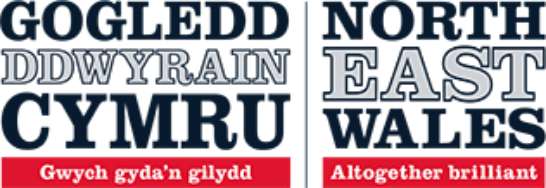Hidden gems in North East Wales just waiting to be discovered
Last week I attended a North East Wales familiarisation trip with an Arts and Culture hidden gems theme.
We started the day with being welcomed by our tour guide Roberta Roberts from Celtic Tour Guide Wales. As we climbed over the Clwydian Range between Ruthin and Mold we were urged to consider the glorious autumnal landscape Roberta was so knowledgeable about and fired my imagination with the legacy of famous artists who had fallen in love with the landscape of North East Wales. From Richard Wilson who was said to have painted the We Three Loggerheads sign to pay off his rather large beer tab to Charles Kingsley the author of Waterbabies who often came to stay and stroll along the river Leete. As we arrived into Mold we passed Y Pentan public house whose signage depicted the famous Mold author Daniel Owen whose character Enoch Hughes mischievously moved the fingers of the clock forward to avoid an overtly long sermon. Roberta explained about the Mold Riots of 1869 where 7 colliers were sentenced to ten years’ hard labour following a disagreement with a local colliery manager, a harsh sentence indeed by today’s standards.
Back to the present and we pulled up by Mold’s war memorial monument which hides the entrance to a rather astonishing hidden gem. I have lived in this area for most of my life and a first for me was to visit the mostly hidden Bailey Hill, the site of a Norman Castle since 1100. We had a very thorough tour from the enthusiastic staff and volunteers who explained that Mold does not appear in the Domesday book because its inception was shortly afterwards. Following the Battle of Hastings, the Normans initiated a settlement in 1086 on a glacial mound which became Bailey Hill because of its commanding view of the area. The word Bailey actually means enclosure and it would have initially been a motte (a clod of earth) where the nobleman would have kept an eye on things and there would have been a 15 foot high wooden fence around the bailey mainly thought to keep livestock. I’ve often wondered how Mold did get its name and they explained how it is thought to have derived from the Norman nobleman Ronald de Mount who lived at Bailey Hill and over the years this became just Mold. In 1277 Llywellyn ap Gruffuth destroyed the castle and the position was much fought over between the lords of Gwynedd, Powys and the English borders. Bailey Hill does in fact now belong to the people of Mold after the great and the good pooled their resources to purchase it from the then Lady Mostyn in 1920. They have lots of exciting new developments with a brand new centre and a castle themed play area planned.
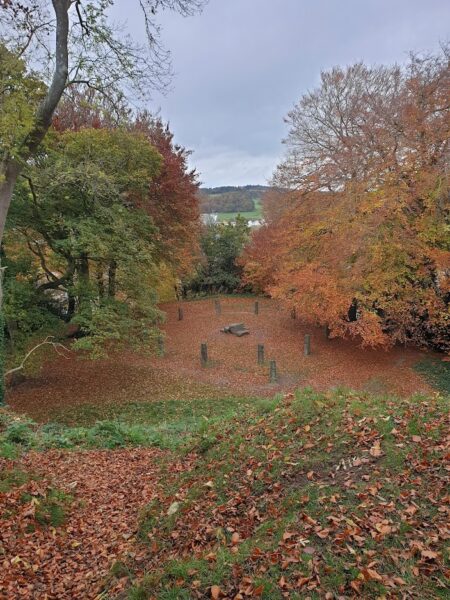
Following the descent into town we then climbed the short distance to the more familiar Theatr Clwyd. After enjoying a delicious lunch we were then in for a real treat, as we were given a behind the scenes tour. The theatre was in the throes of building the sets, planning the lights and sounds and rehearsing the Christmas Panto Beauty and the Beast. It was a real eye opener to see exactly how much preparation went into such a large production, and there was an element of excitement about the refurbishment planned to modernise and improve on the space that is nearly 50 years old.
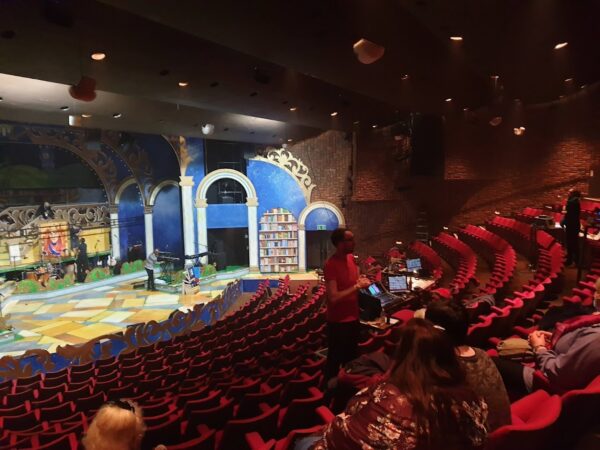
It was back on the bus then to visit a much more tranquil site of St Winefride’s Well in Holywell. This is a truly magical place for anyone who has never been. It is steeped in Royal Pilgrim history and the waters are renowned for their magical healing powers. Most poignant was a pile of antique crutches in the museum left by those who over the years had bathed in the waters and were miraculously cured and no longer needed them. The water in the Sanctuary had a blue tinge and there is a font where you can drink or fill a container and you can also bathe for an hour and a half each day if you are brave enough in the winter months in the Outer pool. Roberta pointed out the ancient graffiti from various visitors to the Crypt some dating back 600 years.
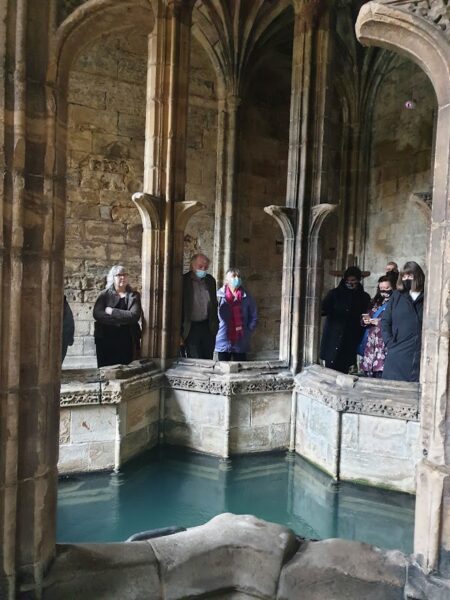
The 12th-century legend behind St Winefride’s Well tells the story of Winifred a young woman who spurned the affections of a local Prince Caradoc who took great offence and beheaded her. A spring rose from the ground at the spot where her head fell and she was later restored to life by her uncle, Saint Beuno and became a Virgin Martyr.
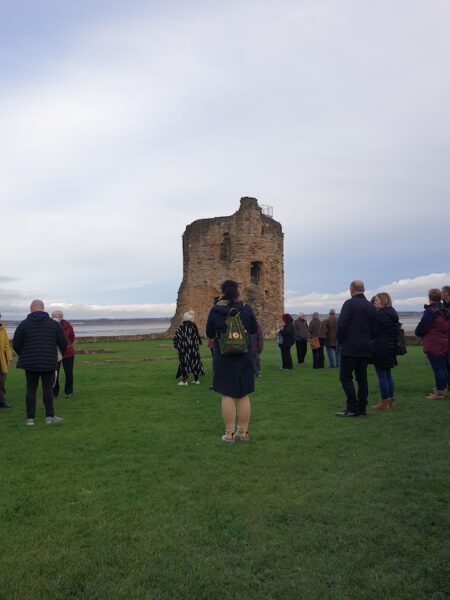
Our last port of call was the equally magical Flint Castle, you don’t normally associate Flint with its high rise housing as a tourist destination however the castle really is special and we were lucky enough to visit late afternoon when the skies had a pink glow. Flint was the first castle of what would later become known as Edward I’s “Iron Ring”. A chain of fortresses designed to encircle North Wales and oppress the Welsh. Its construction began almost immediately after Edward I began the First Welsh War in 1277. It is also famous as the location of a fateful meeting in 1399 between Richard II and his rival to the crown Henry Bolingbroke (later Henry IV), an event immortalised in Shakespeare’s Richard II. A brand new staircase has been installed in one tower. It’s higher than it looks but the climb is really worth it for the view of the Dee Estuary. If you look closely you will see some figures sitting on the benches but you may notice they are rather still, these figures are to commemorate the service men that trained here for the first world war and you see them there staring into sea contemplating their fate. The opposite aptly named Elephant tower by locals as it really does look like an elephant. In keeping with the artistic element of the tour we were shown images of Turner’s painting of the castle and not much has really changed since he captured it so well.
North East Wales never ceases to amaze me with its multi layered rich history laying way for secret gems that just urge you to go exploring and fire the imagination. What’s your favourite North East Wales secret gem?
The project was funded through Denbighshire, Flintshire and Wrexham Councils (North East Wales) and the Welsh Government Rural Communities – Rural Development Programme 2014-2020, which is funded by the European Agricultural Fund for Rural Development and the Welsh Government.
